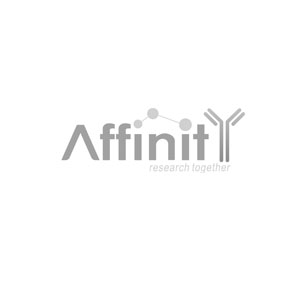NPAT Antibody - #DF14169
| Product: | NPAT Antibody |
| Catalog: | DF14169 |
| Description: | Rabbit polyclonal antibody to NPAT |
| Application: | ELISA(peptide) |
| Reactivity: | Human, Mouse, Rat |
| Mol.Wt.: | 154kD(Calculated). |
| Uniprot: | Q14207 |
Related Downloads
Protocols
Product Info
*The optimal dilutions should be determined by the end user.
*Tips:
WB: For western blot detection of denatured protein samples. IHC: For immunohistochemical detection of paraffin sections (IHC-p) or frozen sections (IHC-f) of tissue samples. IF/ICC: For immunofluorescence detection of cell samples. ELISA(peptide): For ELISA detection of antigenic peptide.
Immunogens
A synthesized peptide derived from Human NPAT.
- Q14207 NPAT_HUMAN:
- Protein BLAST With
- NCBI/
- ExPASy/
- Uniprot
MLLPSDVARLVLGYLQQENLISTCQTFILESSDLKEYAEHCTDEGFIPACLLSLFGKNLTTILNEYVAMKTKETSNNVPAIMSSLWKKLDHTLSQIRSMQSSPRFAGSQRARTRTGIAEIKRQRKLASQTAPASAELLTLPYLSGQFTTPPSTGTQVTRPSGQISDPSRSYFVVVNHSQSQDTVTTGEALNVIPGAQEKKAHASLMSPGRRKSESQRKSTTLSGPHSTIRNFQDPNAFAVEKQMVIENAREKILSNKSLQEKLAENINKFLTSDNNIAQVPKQTDNNPTEPETSIDEFLGLPSEIHMSEEAIQDILEQTESDPAFQALFDLFDYGKTKNNKNISQSISSQPMESNPSIVLADETNLAVKGSFETEESDGQSGQPAFCTSYQNDDPLNALKNSNNHDVLRQEDQENFSQISTSIQKKAFKTAVPTEQKCDIDITFESVPNLNDFNQRGNSNAECNPHCAELYTNQMSTETEMAIGIEKNSLSSNVPSESQLQPDQPDIPITSFVSLGCEANNENLILSGKSSQLLSQDTSLTGKPSKKSQFCENSNDTVKLKINFHGSKSSDSSEVHKSKIEINVLEPVMSQLSNCQDNSCLQSEILPVSVESSHLNVSGQVEIHLGDSLSSTKQPSNDSASVELNHTENEAQASKSENSQEPSSSVKEENTIFLSLGGNANCEKVALTPPEGTPVENSHSLPPESVCSSVGDSHPESQNTDDKPSSNNSAEIDASNIVSLKVIISDDPFVSSDTELTSAVSSINGENLPTIILSSPTKSPTKNAELVKCLSSEETVGAVVYAEVGDSASMEQSLLTFKSEDSAVNNTQNEDGIAFSANVTPCVSKDGGYIQLMPATSTAFGNSNNILIATCVTDPTALGTSVSQSNVVVLPGNSAPMTAQPLPPQLQTPPRSNSVFAVNQAVSPNFSQGSAIIIASPVQPVLQGMVGMIPVSVVGQNGNNFSTPPRQVLHMPLTAPVCNRSIPQFPVPPKSQKAQGLRNKPCIGKQVNNLVDSSGHSVGCHAQKTEVSDKSIATDLGKKSEETTVPFPEESIVPAAKPCHRRVLCFDSTTAPVANTQGPNHKMVSQNKERNAVSFPNLDSPNVSSTLKPPSNNAIKREKEKPPLPKILSKSESAISRHTTIRETQSEKKVSPTEIVLESFHKATANKENELCSDVERQKNPENSKLSIGQQNGGLRSEKSIASLQEMTKKQGTSSNNKNVLSVGTAVKDLKQEQTKSASSLITTEMLQDIQRHSSVSRLADSSDLPVPRTPGSGAGEKHKEEPIDIIKAPSSRRFSEDSSTSKVMVPPVTPDLPACSPASETGSENSVNMAAHTLMILSRAAISRTTSATPLKDNTQQFRASSRSTTKKRKIEELDERERNSRPSSKNLTNSSIPMKKKKIKKKKLPSSFPAGMDVDKFLLSLHYDE
Research Backgrounds
Required for progression through the G1 and S phases of the cell cycle and for S phase entry. Activates transcription of the histone H2A, histone H2B, histone H3 and histone H4 genes in conjunction with MIZF. Also positively regulates the ATM, MIZF and PRKDC promoters. Transcriptional activation may be accomplished at least in part by the recruitment of the NuA4 histone acetyltransferase (HAT) complex to target gene promoters.
Phosphorylated at Ser-775, Ser-779, Ser-1100, Thr-1270 and Thr-1350 by CCNE1/CDK2 at G1-S transition and until prophase, which promotes association with histone gene clusters and stimulates activation of histone transcription. Also phosphorylated by CCNA1/CDK2 in vitro.
Nucleus. Nucleus>Cajal body.
Note: Concentrates in two Cajal bodies tethered to histone gene clusters at chromosome 6p21 during G1, S and G2 phases. Also concentrates in two additional Cajal bodies tethered to histone gene clusters at chromosome 1q21 specifically during S and G2 phases.
Ubiquitously expressed.
Interacts with the cylin/CDK complexes CCNE1/CDK2 and CCNA1/CDK2. Interacts with BZW1, CASP8AP2, CREBBP, MIZF and YY1. Interacts with the RUVBL1, RUVBL2 and TRRAP subunits of the NuA4 complex. May also interact with GAPDH, NME1, NME2 and STIP1.
The LisH domain is required for the activation of histone gene transcription.
Belongs to the NPAT family.
Restrictive clause
Affinity Biosciences tests all products strictly. Citations are provided as a resource for additional applications that have not been validated by Affinity Biosciences. Please choose the appropriate format for each application and consult Materials and Methods sections for additional details about the use of any product in these publications.
For Research Use Only.
Not for use in diagnostic or therapeutic procedures. Not for resale. Not for distribution without written consent. Affinity Biosciences will not be held responsible for patent infringement or other violations that may occur with the use of our products. Affinity Biosciences, Affinity Biosciences Logo and all other trademarks are the property of Affinity Biosciences LTD.
